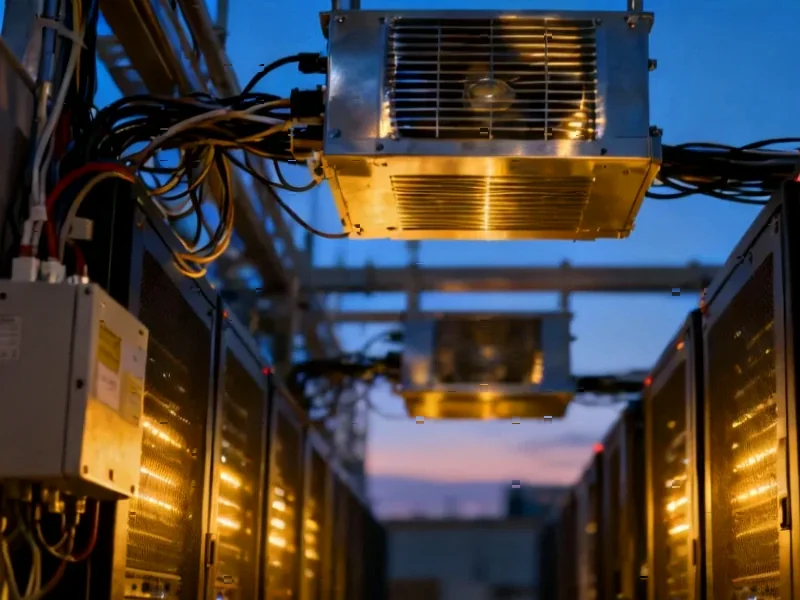According to TheRegister.com, xFusion presented at GITEX Global 2025 in Dubai a comprehensive hardware strategy addressing critical AI infrastructure challenges, particularly the thermodynamic limitations threatening ROI on billions in AI investments. The company’s “Black Technology” suite includes innovations like direct liquid cooling achieving 1500W cooling capacity, thermal interface materials doubling conductivity, and liquid coolant delivering 10% faster heat transfer. Their FusionPoD system demonstrates proven pPUE of less than 1.06, significantly below the global average of 1.56 and even Google’s cutting-edge 1.09 average. xFusion also showcased custom power supply units achieving 96.2% efficiency and high-speed interconnects with 10% higher IO density, while emphasizing their Middle East expansion supporting Saudi Arabia’s Vision 2030 with deployments in extreme environments like the Sahara at 55°C. This holistic approach addresses what may become AI’s most fundamental constraint: the laws of physics themselves.
The Thermodynamic Wall
While most AI coverage focuses on model architectures and training techniques, the industry is quietly approaching a thermodynamic wall that could halt progress faster than any algorithmic limitation. NVIDIA’s roadmap includes 1KW GPU racks that essentially function as industrial heaters with computational side effects. The challenge isn’t just cooling these systems but doing so economically – every watt spent on cooling is a watt not spent on computation, and at hyperscale, these inefficiencies compound into billions in wasted capital.
Geographic Winners and Losers
The AI infrastructure race will create unexpected geographic winners beyond traditional tech hubs. Regions with abundant renewable energy, cool climates, and stable water access will have natural advantages, while tropical and arid regions face structural disadvantages that even advanced cooling can’t fully overcome. This creates a paradox: the Middle East has cheap power and land but faces extreme cooling challenges, while Northern Europe has ideal cooling conditions but higher operational costs. Companies like xFusion that can deliver efficiency gains in hostile environments may enable entirely new AI geography, but the fundamental physics still favor certain locations over others.
The Sustainability Paradox
AI’s environmental impact represents a classic Jevons paradox: as efficiency improves, consumption increases because more applications become economically viable. The Uptime Institute’s global PUE average of 1.56 shows how much room for improvement exists, but even Google’s industry-leading 1.09 represents massive absolute energy consumption given their scale. The real sustainability challenge isn’t just improving efficiency but managing the total energy budget as AI workloads continue exponential growth. Companies that master both efficiency and scale will have a decisive advantage as regulatory pressure mounts.
Enterprise Adoption Realities
For most enterprises, the AI infrastructure decision isn’t about peak performance but about predictable total cost of ownership. The difference between 96% and 94% power supply efficiency might seem trivial until you calculate the cumulative effect across thousands of servers over multiple years. More importantly, reliability becomes non-negotiable – while a model training interruption might cost time and money, failures in production AI systems for healthcare, autonomous vehicles, or financial trading could have catastrophic consequences. This explains why companies like xFusion emphasize their ENAGEO case study showing two-thirds reduction in downtime under extreme conditions.
The Power Resilience Imperative
As AI moves from training to inference and real-time applications, power resilience becomes a safety-critical requirement. Traditional datacenter redundancy models designed for web services won’t suffice for AI-powered medical diagnostics, autonomous systems, or industrial control. The hot-swappable, modular power systems xFusion demonstrates represent a necessary evolution toward fault-tolerant AI infrastructure. The industry is learning that you can’t simply scale existing datacenter designs – you need fundamentally different architectures when failure means more than website downtime.
Regional Strategic Implications
The Middle East’s aggressive AI investments, supported by PwC’s analysis of regional advantages, represent a strategic bet that they can overcome environmental challenges through technology. Saudi Arabia’s Vision 2030 depends on transforming sectors like healthcare and manufacturing through AI, but this requires solving the fundamental physics problem in one of the world’s most challenging climates. Success would position the region as a global AI leader; failure would demonstrate that some physical constraints can’t be engineered around, no matter how much capital is available.
The Future Infrastructure Landscape
Looking forward, we’re likely to see increasing specialization in AI infrastructure. General-purpose cloud providers will coexist with specialized AI factories optimized for specific workloads and environmental conditions. The companies that thrive will be those that treat thermodynamics as a first-class design constraint rather than an afterthought. As Google’s efficiency leadership demonstrates, marginal gains compound into decisive advantages at hyperscale. The next decade of AI progress may depend less on brilliant algorithms than on brilliant cooling systems and power delivery – the unsexy but essential physics that enable the magic.




